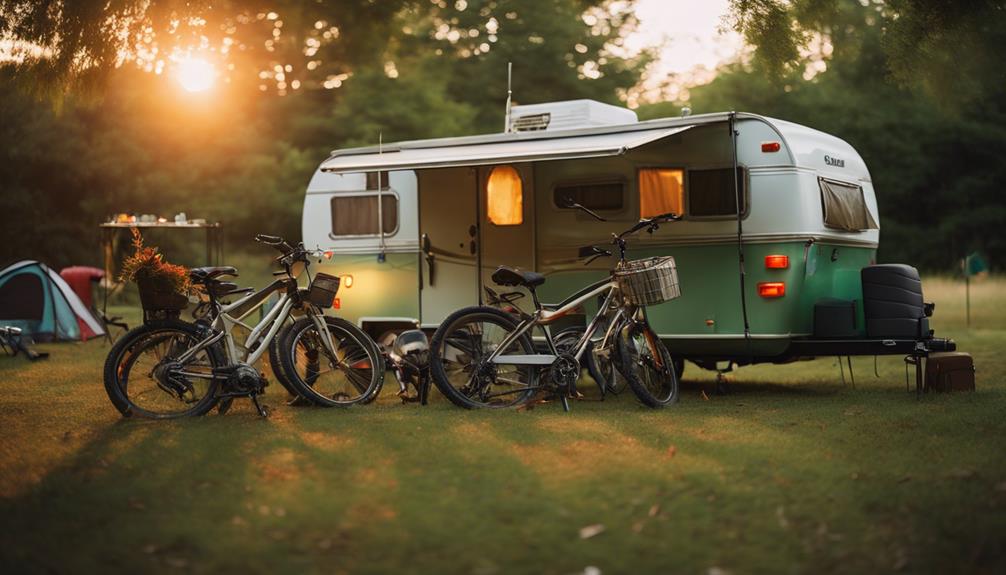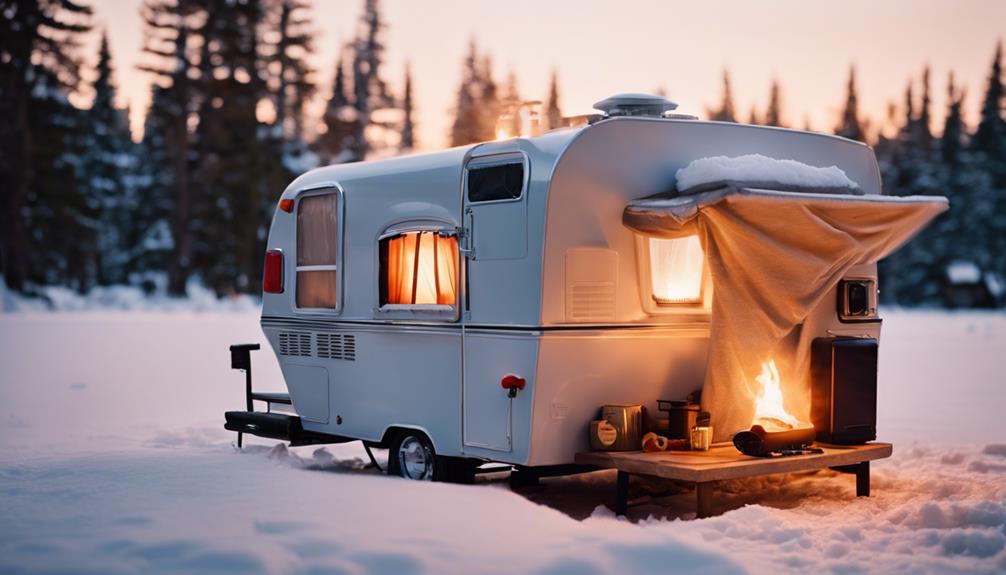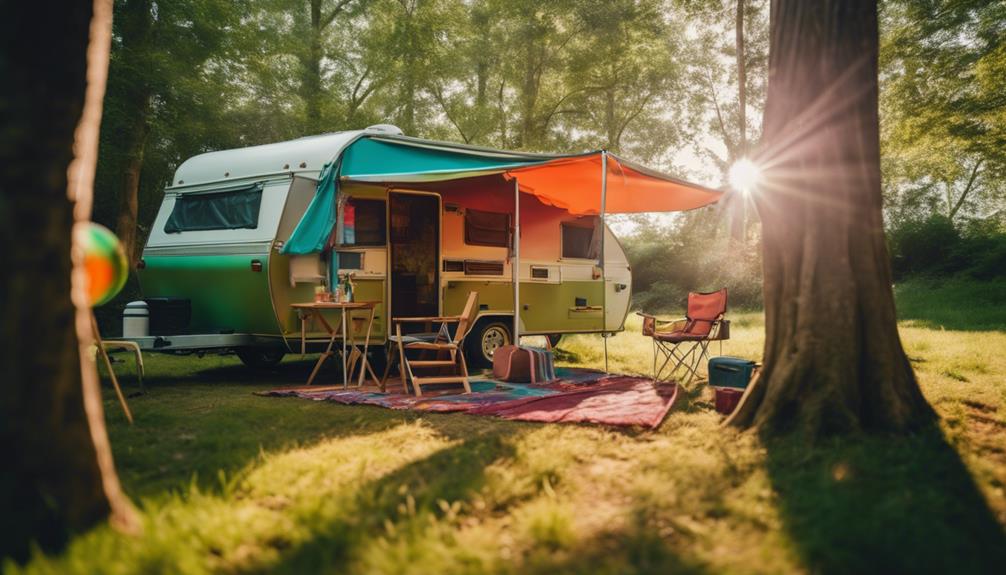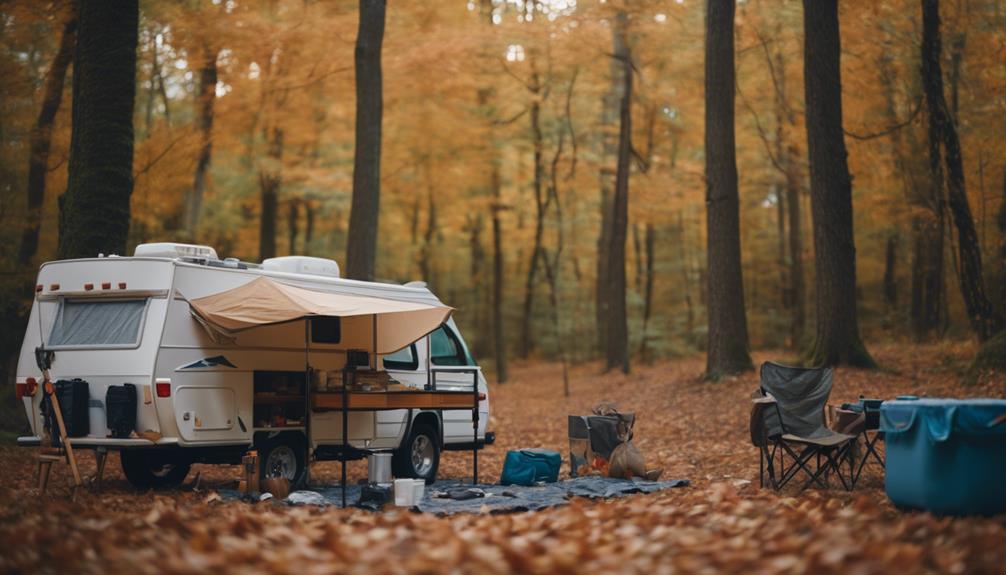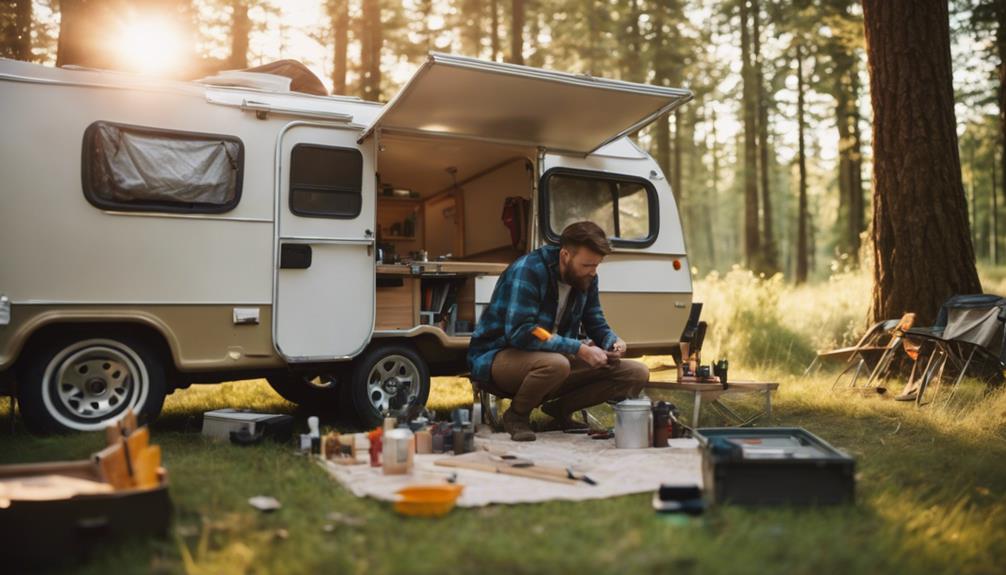Attaching bikes to your pop-up camper is easy and enhances your outdoor adventures. You can choose from roof racks, hitch-mounted racks, or even DIY solutions using built-in load rails. Make sure to prioritize weight distribution for stability and safety during travel. Use quality straps to secure your bikes and regularly inspect your rack for wear and tear. Front-mounted hitches can offer easy access while ensuring that bikes don't interfere with the camper. With a bit of planning and the right equipment, you'll get your bikes along without hassle. There's plenty more to explore on optimizing your setup!
Key Takeaways
- Choose the right bike rack type, such as hitch-mounted or roof racks, ensuring compatibility with your pop-up camper.
- Ensure proper weight distribution and secure attachment to maintain camper stability during travel.
- Regularly inspect bike racks and straps for wear to prevent damage and ensure safe transport.
- Utilize built-in load rails for a cost-effective and stable bike mounting solution on your camper.
Overview of Pop-Up Campers
Pop-up campers are lightweight trailers designed to collapse for easy transport, making them perfect for your camping adventures. These trailers combine convenience and comfort, featuring expandable sections that provide essential amenities for your camping trips.
When you're looking for a tow vehicle, remember that the camper weight limits must be adhered to, guaranteeing safe towing and a smooth journey.
Brands like Palomino and Tundra offer various models of pop-up campers tailored for family or solo travel. Their lightweight design allows you to easily maneuver and store them when not in use. Many models come equipped with built-in load rails, which enable you to attach a bike carrier or other gear, making it easier to take your bikes along for the ride.
Before hitting the road, always check the total weight of your camper, including any additional gear like bikes. This way, you'll stay within the camper weight limits and guarantee a safe transport experience.
With the right pop-up camper, you can elevate your outdoor adventures while bringing along everything you need for exploration.
Bike Rack Options
Which bike rack option suits your pop-up camper best depends on your needs and preferences for transporting your bikes securely. Here's a quick comparison of popular options:
| Bike Rack Type | Pros | Cons |
|---|---|---|
| Roof Racks | Securely transport multiple bikes | Requires proper installation and weight limits |
| Hitch-Mounted Bike Racks | Easy to load and unload, popular choice | May affect tongue weight and clearance |
| Trunk-Mounted Carriers | Cost-effective and easy to use | Can interfere with tongue, raising stability concerns |
| Custom DIY Bike Carriers | Personalized to fit your camper | Requires effort and materials for construction |
When selecting a bike rack, consider the weight distribution of your pop-up camper. Roof racks are great for multiple bikes, while hitch-mounted options are convenient but need monitoring for stability concerns. Trunk-mounted carriers are simpler but may not be the best for all models. If you're handy, custom DIY bike carriers can offer a tailored solution for secure transport without breaking the bank. Choose wisely to guarantee your biking adventures are safe and enjoyable!
Safety Considerations
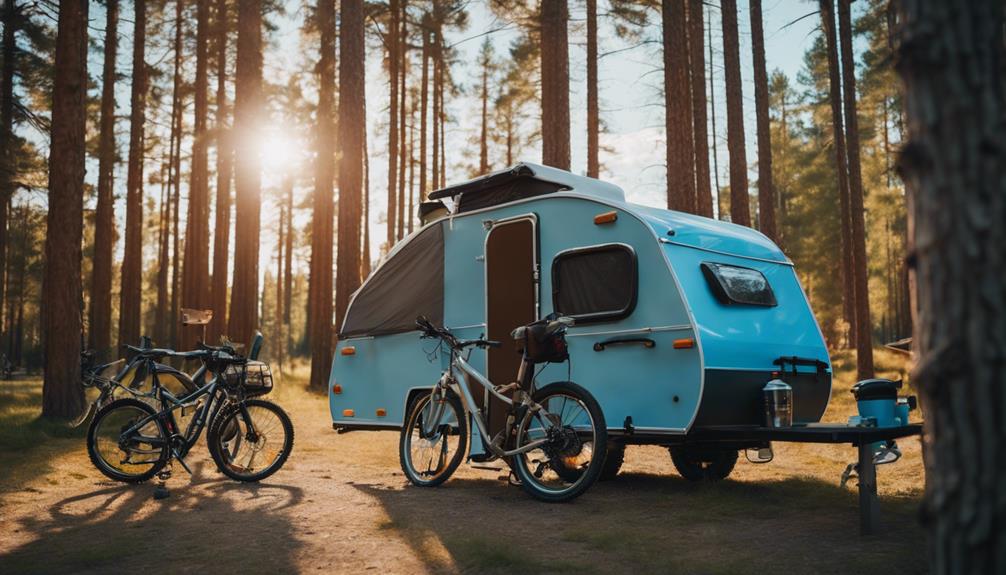
Ensuring your bike is securely attached to your pop-up camper is essential for safe travel and avoiding potential accidents on the road. Here are some key safety considerations to keep in mind:
- Weight Distribution: Make sure your bike rack is evenly balanced. Overloading the rear bumper can lead to structural instability while towing.
- Regular Inspection: Check your bike rack and hitch regularly for wear and tear. This maintenance is vital for preventing issues that could compromise your bikes' security during transport.
- Stabilizing Your Bikes: Use quality straps to secure your bikes properly. Stabilizing them reduces movement, which lessens the risk of damage to both your bikes and your camper.
- Monitor Tongue Weight: Be mindful of the tongue weight when using hitch-mounted racks. Exceeding recommended limits can negatively affect your towing vehicle's handling and stability.
Consider utilizing a front-mounted hitch for improved visibility and access while ensuring that brake lights remain unobstructed.
DIY Bike Transport Solutions
When it comes to DIY bike transport solutions, custom rack construction can make a world of difference.
You can create a secure setup that keeps your bikes safe while traveling.
Plus, ensuring your bikes are properly secured will help prevent any damage during your adventures.
Custom Rack Construction
Building a custom bike rack for your pop-up camper can enhance your outdoor adventures while keeping your bikes secure during travel. With the right materials and design, you can create a DIY bike carrier that meets your needs. Here's how to get started:
- Materials: Use wood and carpet samples to construct your rack. A 2×4 with padded feet provides stability.
- Attachment Points: Incorporate eye bolts and strong attachment points to guarantee your rack can withstand the stresses of travel.
- Load Rails: If your pop-up camper has built-in load rails, utilize them for attaching your bike carrier, making it a cost-effective solution.
- Removable Solution: Use ratchet straps to create a removable bike carrier, allowing for easy loading and unloading without drilling into your camper.
Engaging with community forums can also provide inspiration and guidance for your custom rack construction.
Securing Bikes Safely
To keep your bikes secure during travel, consider using bungee cords inside the camper to stabilize the wheels and prevent shifting. This method not only keeps the bikes in place but also protects the camper's interior from damage.
If you want a more permanent solution, explore custom welding options for a hitch-mounted bike rack. This addition enhances stability and makes loading and unloading a breeze.
You could also utilize the built-in load rails in your pop-up camper. By attaching a compatible bike rack to these rails, you create a secure transport solution that maintains the camper's integrity. Just make certain to regularly check and maintain all attachment points and straps for wear. This guarantees your bikes remain securely fastened throughout your journey.
If you're looking for a DIY option, consider crafting a bike carrier from a 2×4 with padded feet and eye bolts. This removable rack doesn't require drilling into the camper's structure, making it a practical choice.
No matter which method you choose, securing your bikes effectively is essential for safe travels.
User Experiences and Recommendations

Many campers recommend using roof racks like the Yakima Frontloader for securely transporting bikes on pop-up campers. This method keeps your bikes on the roof, maintaining the camper's integrity and freeing up space. Many users have also found double hitch extensions to be a cost-effective solution, allowing you to tow your camper while carrying bikes securely.
Here are some popular recommendations from the camping community:
- Use Supplemental Straps: Secure bikes with additional straps to prevent movement and potential damage during your trip.
- Consider DIY Roof Mounts: Custom modifications using local materials can be both effective and affordable for securing your bikes.
- Opt for Front-Mounted Hitches: These provide easy access to bikes without blocking the rear of your camper, making loading and unloading more convenient.
- Explore Various Bike Carriers: Different styles of bike carriers cater to various camper setups, so choose one that fits your needs best.
Weight Distribution and Stability
Guaranteeing proper weight distribution is vital for maintaining stability when transporting bikes on your pop-up camper. Exceeding the maximum tongue weight, typically around 350 lbs for vehicles like the Honda Odyssey, can lead to sagging and instability.
When using hitch-mounted bike racks, you must monitor total weight to avoid overloading the rear bumper, which can cause structural issues and swaying during travel. The soft suspension of your vehicle often limits its carrying capacity, so consider using airbags or other modifications to maintain stability as you add bikes and gear to the rear.
Always secure bikes properly and verify they're balanced; this helps prevent movement during transit, minimizing the risk of damage to both the camper and your bikes. Additionally, utilizing a dual hitch extension can greatly improve maneuverability and weight distribution.
This setup allows you to tow the camper while safely carrying bikes without exceeding safety limits. By focusing on these aspects, you can enjoy your biking adventures without compromising stability and safety on the road.
Maintenance and Care Tips
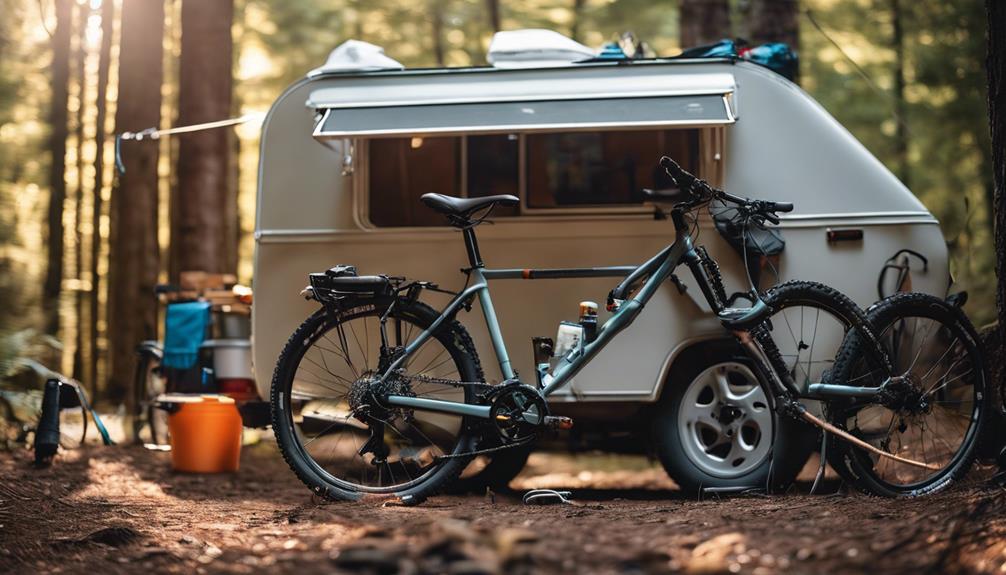
How often do you check your bike racks and attachment points for wear and tear to confirm safe transportation on your pop-up camper? Regular maintenance is vital for guaranteeing both safety and the longevity of your gear.
Here are some essential care tips to keep your bikes in top shape:
- Inspect Racks and Attachments: Before each trip, examine your bike rack and its attachment points for any signs of wear and tear. Replace any worn components immediately.
- Clean After Use: After every outing, clean your bikes and camper to prevent rust and damage, especially if you've been in saltwater or muddy conditions.
- Tire Maintenance: Always check your bike tires for proper inflation and tread wear before hitting the road. This simple step enhances safety and performance.
- Proper Storage: When not in use, store your bikes indoors or under protective covers to shield them from environmental damage.
Additionally, don't forget to use lubricants on moving parts like gears and chains to reduce friction.
Community Resources for Biking
Online platforms and local biking clubs offer essential resources that enhance your biking adventures while camping. You can join forums like Expedition Portal to share experiences and gather advice on bike transport with pop-up campers. Local biking clubs and camping organizations often provide maps and host biking events that improve both camping and biking experiences.
Community centers are valuable for resource guides and workshops focused on bike maintenance and safety regulations. These centers can help you learn the best practices for transporting your bike and keeping it in top shape during your travels. You'll find that DIY modifications shared by community members can offer tailored solutions for specific camper designs, allowing you to customize your bike transport setup.
Participating in camper rallies and biking events is another great way to network with fellow enthusiasts. These gatherings give you the chance to exchange tips, discover new biking routes, and meet like-minded individuals who share your passion. By tapping into these community resources, you can elevate your camping experience while ensuring your biking adventures are seamless and enjoyable.
Traveling With Bikes in Diverse Terrains
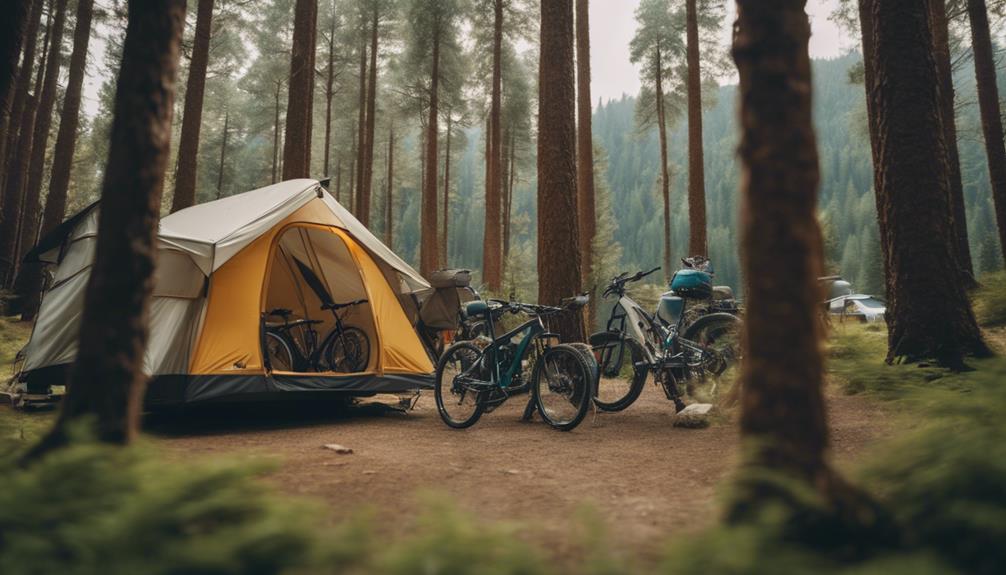
Traveling with bikes across diverse terrains requires careful planning to maintain your pop-up camper's stability and safety. When maneuvering hilly or rough roads, uneven weight can compromise handling. Here are some essential tips to guarantee a smooth journey:
- Check Weight Distribution: Make certain your bikes are evenly distributed on your roof racks or bike rack. This maintains the camper's stability and performance.
- Select the Right Roof Racks: Invest in quality roof racks that securely hold your bikes. They should be compatible with your pop-up camper to prevent damage during travel.
- Understand Biking Regulations: Research local biking regulations and trail guidelines in the areas you'll visit. Compliance guarantees you enjoy your ride without legal issues.
- Engage with Local Biking Communities: Connect with local biking communities. They can offer valuable insights on safe trails and provide safety tips tailored to the specific terrain.
Frequently Asked Questions
How Do You Transport Bikes With Camper Trailer?
To transport bikes with your camper trailer, consider using a hitch-mounted rack for stability, or a roof rack if you don't mind removing them. Always secure bikes properly and check weight distribution for safety.
How Do You Mount a Bike on an Rv?
Mounting a bike on an RV is like securing a treasure; use a sturdy hitch-mounted rack or roof rack, ensuring it's weight-appropriate. Regularly check straps and attachment points to keep your adventure safe and smooth.
Can You Attach a Bike Rack to a Trailer?
Yes, you can attach a bike rack to a trailer. Just make sure you check weight distribution and compatibility with your trailer's frame. Consider using a dual hitch extension for towing and carrying bikes simultaneously.
How Do You Store a Bike in a Camper?
To store a bike in your camper, remove the front wheel if necessary, secure it with bungee cords or padded straps, and check that it's stable. Consider using DIY mounts for more efficient space usage.
What Are the Best Ways to Secure Bikes to a Pop-Up Camper for Travel?
Securing bikes to a pop-up camper for travel requires the best methods for carrying bikes to ensure they stay safe and secure during the journey. Consider using a bike rack specifically designed for pop-up campers, or installing a hitch receiver to attach a bike rack. Always double-check the security of the bikes before hitting the road.
Conclusion
Whether you're cruising through serene forests or tackling rugged mountain trails, bringing your bikes along can transform your camping experience.
A pop-up camper offers the perfect balance of comfort and adventure, but attaching bikes requires careful planning.
From choosing the right bike rack to ensuring weight distribution, each step enhances your journey.
So, gear up and hit the road! With the right preparation, you won't just camp; you'll create unforgettable memories on two wheels.

